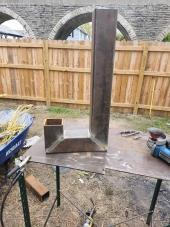


Rob Millard wrote:Here is a 1st gen. cooker I whipped up in an afternoon to try a proof of concept. The air holes I added up the side were to induce a vortex in the exhaust. Originally 5 holes with 2 of them below the top of the feed tube junction were muddling the air path. Once I filled in the ones below the joint then enlarged & added one it worked noticeably better. I probably could have done just one or even no holes but it was a test project so. (Shrug) This shot was after it had just gone out & before my mods. The tube was 3" since that was what I had & the riser was about 18" tall. The top were just offcuts of the same with bits of bar to hold them together in an open grid.

Samantha Lewis wrote:Hello Eric!
What is the spalling temperature of the metal you are using?
Usually we make the rocket stoves out of refractory materials because they get well over 1000 degrees.

Eric Champlin wrote:
Nancy Reading wrote:Hi Eric - Welcome to Permies!
Can you describe the problem you are having? If I were to guess as an inexperienced stove tinkerer, I would say that your stove is not rocketing because the riser is not insulated.
How can i insulate it and still take it camping?

Nancy Reading wrote:Hi Eric - Welcome to Permies!
Can you describe the problem you are having? If I were to guess as an inexperienced stove tinkerer, I would say that your stove is not rocketing because the riser is not insulated.

Glenn Herbert wrote:If you are making a permanent installation outdoors, or can sink part of the core below floor level, a J-tube would work excellently for a cookstove. An L-tube would require bending down to check the fire and feed it unless the top is higher than you would want.
Granite would crack very quickly from the extreme concentrated heat. It can stand a lot of heat, but not uneven heat.